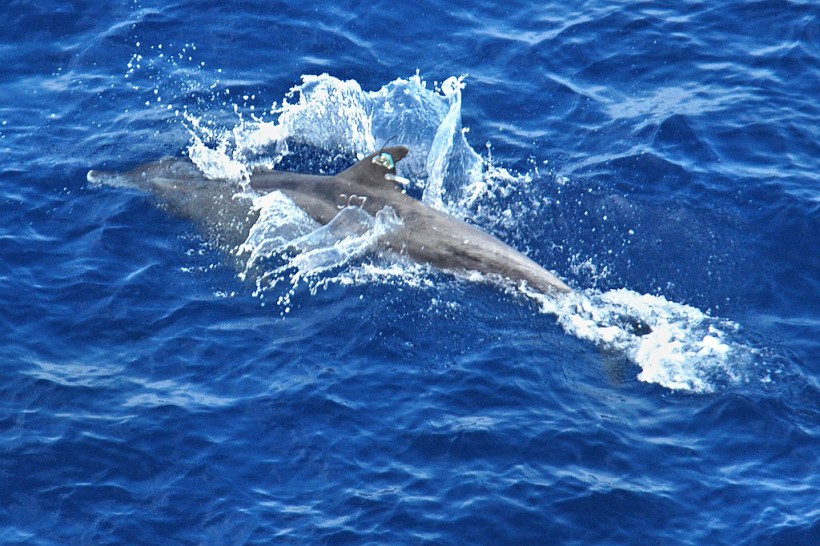On Friday, an orphaned male calf named Ranger was brought to the Florida Keys-based Dolphin Research Center for permanent sanctuary after it spent nine months of treatment at a Texas-based marine rehabilitation center.
According to a Phys.org report, the juvenile bottlenose dolphin was rescued in June last year, after it was discovered stranded in waters around the Texas-based Goose Island State Park.
The dolphin was suffering from an underlying respiratory infection and dehydration when it was found. He was discovered close to his dead mother and was brought to the Texas State Aquarium Wildlife Rescue Center.
The National Marine Fisheries Service determined that the dolphin could not provide service in the wild and opted for the Dolphin Research Center to permanently care for the marine mammal.
ALSO READ: Dolphins Control Their Heart Rates to Avoid Decompression Sickness

One of seven recovered rough-toothed dolphins skims the Atlantic Ocean's surface after being released 14 nautical miles off the Florida Keys May 3, 2005, near Key Largo, Florida.
'Forever Home'
Linda Erb, vice president of animal care and training of the DRC, said they provide sanctuary for any dolphin that needs a forever home. More often than not, she added that when a dolphin-like Ranger is found at a very young age, "he has not learned the skills to catch his own fish."
Operations coordination for Texas State Aquarium Sarah Zigmond was at DRC for the arrival of Ranger. She said she had been with the dolphin since his rescue. To see the culmination of his full rescue and rehabilitation "come to fruition" in his new permanent home, she was quite emotional, although it was all happy emotions.
After a preliminary monitoring period in a medical quarantine pool to build up Ranger's immune system, the dolphin will be slowly introduced to other resident dolphins, not to mention, acclimate to the dolphin lagoons in Florida Bay, a similar CBS Miami report specified.
Rehabilitated dolphin named arrives at Florida Keys facility https://t.co/1cUkyGIYZY
— CBS News Miami (@CBSMiami) March 26, 2022
Dolphin Rehabilitation
According to the Texas Marine Mammal Stranding Network, when a live stranded marine mammal is found or reported to them, it is evaluated on-site.
Following assessment, an informed decision on "transport and entry" into rehabilitation is made. Upon arrival to the center, TMMSN begins intensive critical care immediately of the patient, offering medical and nutritional support.
A veterinarian carries out a physical examination, performs diagnostics, and develops a care plan. Through a diagnostic process, the center attempts to detect inflammatory and zoonotic disease and injury and trauma.
Many times, there is a need for an animal to be supported in the water around the clock until it gets strong enough to swim independently. More so, detailed clinical, behavioral, and laboratory behaviors are kept on each of the animals' cases.
Release of Marine Mammals and Return to the Wild
The main objective of the National Marine Fisheries Services Standards for Release is the marine mammal's release to return to the wild. When there are available resources, released animals are affixed with a radio-tracking device or satellite, and monitored by TMMSN.
Animal patients deemed non-releasable by NMFS because of their inability to survive in the wild, are brought to a permanent accredited care facility chosen by NMFS.
If, based on veterinary evaluation, a live-stranded animal-like Ranger is not considered a good rehabilitation candidate, or its condition does not improve with rehabilitation, a decision will be made for humane euthanization.
Related information about dolphins in the Florida Keys is shown on RadioLynxContent's YouTube video below:
RELATED ARTICLE: Calamity the Dolphin Who Was Saved Twice From Tangled Fishing Lines Dies Months After Partner Bucky Passed Away
Check out more news and information on Dolphins in Science Times.



![Earth's Quasi-Moon Kamo‘oalewa Could Originate From Lunar Surface Not Asteroid Belt [Study]](https://1721181113.rsc.cdn77.org/data/thumbs/full/53275/89/56/50/40/earths-quasi-moon-kamo-oalewa-could-originate-from-lunar-surface-not-asteroid-belt-study.png)










